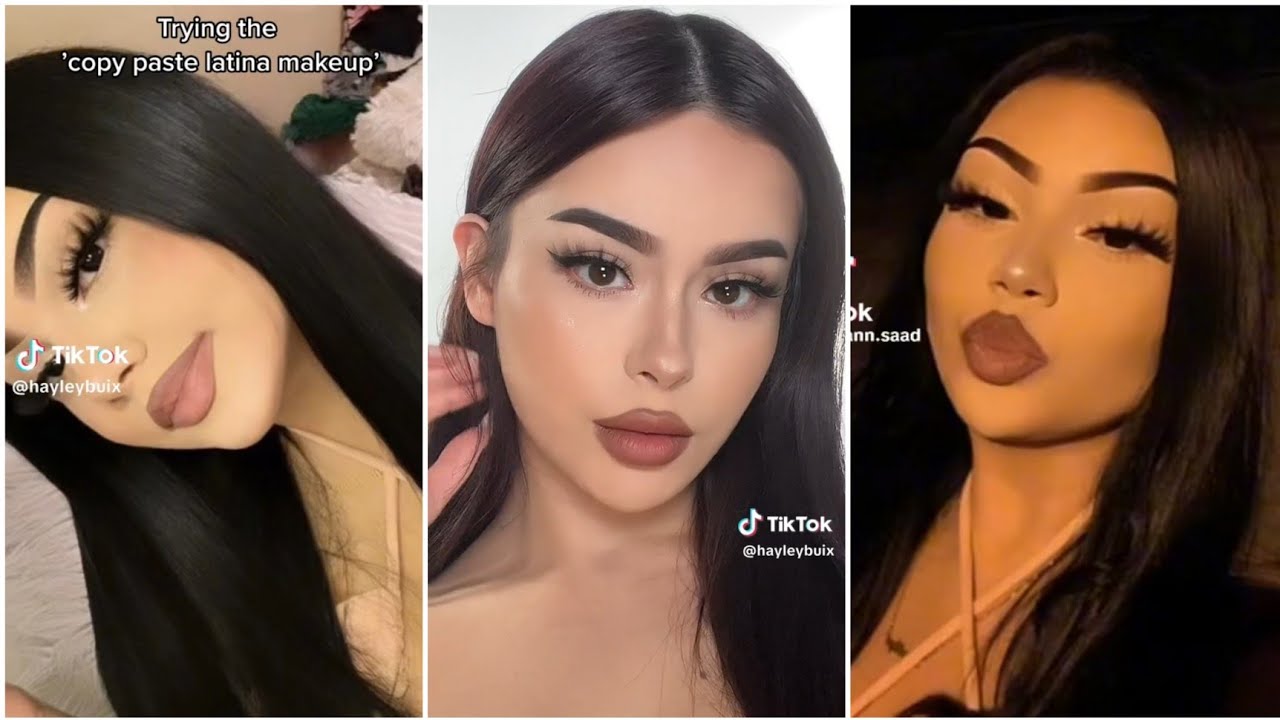In recent weeks, the term “copy and paste Latina” has resurfaced on TikTok which has sparked both attention and concern. The term “copy and paste Latina” has received a reputation, with users across the platform exploring the idea of embodying certain bodily and cultural trends that can be stereotypically related to Latina girls. While at first, the phrase might also appear innocent, its implications are extra unfavorable. In this newsletter, we explore the upward thrust of this fashion, its dangerous outcomes on identification, and why it’s vital to apprehend its outcomes.
What Does “Copy and Paste Latina” Mean?
The “copy and paste Latina” term became famous under a viral TikTok sound in early October 2022. While the term itself stays truly ambiguous, the motion pictures that have emerged below this hashtag depart little to the imagination. The “copy-paste” label usually refers to girls who match a narrow, enormously unique set of bodily characteristics that the U.S. Public commonly associates with Latina women. These developments frequently encompass:
Silky black hair
Light skin
Eurocentric facial functions
Heavy, female make-up
The period is used to explain folks who encompass those traits to the point that they nearly look like “copies” of one another. In essence, they represent a homogenized, one-size-suits-all model of Latina beauty.
The Positive Side: An “Aesthetic” to Be Coveted?
On one aspect of the trend, there are TikTok users who gift the “copy and paste Latina” aesthetic as something to be preferred. These creators often post tutorials and transformation videos, demonstrating a way to obtain the “look.” The portrayal of this aesthetic as aspirational and elegant can inspire visitors to undertake comparable splendor requirements.
For some, this might seem harmless or maybe empowering, as it gives human beings a way to rejoice in Latina beauty in a mainstream, cutting-edge way. In truth, beauty influencers have frequently capitalized on this trend, showing off strategies to mimic the look and providing merchandise to obtain it. On the floor, it may seem like an opportunity to celebrate renowned Latina aesthetics, however, the underlying implications are far more complex.
The Negative Side: Mocking and Reducing Latina Identity
On the alternative facet of the trend, some films mock or laugh at girls who adhere to the “copy and paste Latina” stereotype. These films highlight how women with these trends are frequently praised or renowned, whilst others who don’t shape the mold are ignored or ridiculed. This mocking tone can be tremendously adverse, mainly while it targets the very idea of Latina identity itself.
By highlighting those narrow beauty requirements, the fashion suggests that most effective women who comply with this precise appearance may be considered authentically “Latina.” This erases the variety of Latina stories and backgrounds, lowering a complex and sundry institution of humans to simply a fixed of physical developments. The message this sends is dangerous, as it implies that there’s a “proper” manner to be Latina, which is a risky and oversimplified perception.
The Harmful Impact on Latina Identity
The “copy and paste Latina” fashion does more than simply make stronger slim beauty standards — it additionally perpetuates cultural erasure and racial discrimination. Latina ladies come from a big selection of cultural, ethnic, and racial backgrounds, and their stories can vary substantially depending on where they may be from, their history, and their non-public journey. By specializing in a novel look, the fashion ignores the intersectionality of Latina identification, which incorporates various pores and skin tones, frame kinds, and cultural expressions.
The truth is that no longer every Latina has silky black hair, light skin, or Eurocentric functions. Many Latina ladies, specifically those of Afro-Latina, Indigenous, or mixed-race backgrounds, so don’t agree with this limited and regularly Eurocentric ideal. When the “copy-paste Latina” aesthetic dominates the verbal exchange, it similarly marginalizes those women, sending a message that they are what may be much less Latina or no longer Latina sufficient.
The Consequences of “Copy and Paste” Stereotypes in Media
The rise of “copy-paste Latina” reflects a bigger trouble inside the way that Latina girls are often represented in the media. For years, Hollywood and other cultural industries have perpetuated a specific photograph of what it approaches to be Latina — one that is often restrained, idealized, and closely prompted via Western standards of splendor. This stereotype, even as evolving in some approaches, continues to shape the manner Latina girls are visible and handled in society.
When media and platforms like TikTok sell a slender, simplified version of Latina identification, it has real-world results. For many Latina ladies, it could cause emotions of inadequacy or alienation, as they may feel forced to comply with a super that does not replicate their authentic selves. In extreme instances, it can additionally affect how they are perceived by others, both in phrases of their price and their authenticity.
The Danger of Idealizing Eurocentric Standards
One of the most dangerous elements of the “copy and paste Latina” fashion is how it perpetuates Eurocentric beauty requirements. These requirements have long dominated media and style industries, and the promoting of such beliefs on a platform like TikTok best further ingrains them into the normal subculture.
By focusing on traits that can be considered conventionally “stunning” in Eurocentric terms, the trend reinforces a unique picture of Latina girls. It suggests that to be accepted, loved, or valued, Latina ladies need to conform to these Western beliefs. This no longer best disregards the diversity in the Latina community but also undermines the importance of cultural historical past and man or woman expression.
Why the Trend is Harmful
The “copy and paste Latina” trend is harmful because it enforces a completely slim and unrealistic expectation of what Latina ladies need to seem like and how they should present themselves. This trend inadvertently excludes many Latina girls whose features no longer align with the Eurocentric splendor requirements that dominate popular culture. Moreover, it reduces Latina ladies to mere visible objects, reinforcing the damaging concept that look is the most crucial aspect of their identification.
Furthermore, this fashion can perpetuate cycles of insecurity and self-doubt, as girls who no longer match the “copy-paste” mildew may also sense that they may be not worthy of equal attention or admiration. This strain to conform can result in anxiety about their appearance and a sense of disconnect from their very own cultural identification.
Moving Toward Positive Representation
To pass far away from the harmful results of the “copy-paste Latina” trend, it’s essential to promote greater inclusive, various, and genuine representations of Latina ladies. This consists of recognizing the huge variety of beauty, persona, and cultural traits that exist inside the Latina network.
Social media platforms like TikTok have the strength to form public opinion and impact cultural norms. Instead of celebrating one slender photo of Latina identification, those platforms can expand voices from across the spectrum, inclusive of those from Afro-Latinas, Indigenous Latinas, and those with extraordinary physical trends.
It’s also important for Latina creators and influencers to use their platforms to venture stereotypes and showcase the richness of their history. By diversifying the content and narratives shared on structures like TikTok, we can promote a greater actual and inclusive imaginative and prescient of what it approaches to be Latina.
FAQs
Q: What is the “copy and paste Latina” trend?
A: The “copy and paste Latina” fashion refers to the merchandising of a particular set of bodily tendencies (like light pores and skin, silky black hair, and Eurocentric functions) as the perfect search for Latina girls on TikTok.
Q: Why is this trend dangerous?
A: This fashion promotes slim beauty standards, marginalizing Latina women who don’t match the mold, and reinforcing harmful stereotypes that erase the range within Latina identities.
Q: How does this fashion affect Latina women?
A: Latina girls who no longer conform to the “copy-paste” look can also revel in feelings of alienation, inadequacy, and an experience of being “less Latina,” leading to harm to shallowness and cultural identification.
Q: What must be finished to cope with this issue?
A: To fight this fashion, it’s crucial to promote diverse, inclusive representations of Latina girls and celebrate the various varieties of splendor and identification inside the network.
Conclusion
The “copy and paste Latina” trend on TikTok is a reflection of broader societal problems surrounding splendor requirements and cultural illustration. While the fashion might also appear lighthearted or harmless on the floor, it perpetuates harmful stereotypes and bounds the way Latina girls are seen and understood. By embracing range and inclusivity, we will start to break down these boundaries and create an extra real and empowered illustration of Latina identification. We must have fun with all styles of beauty and all expressions of the Latina way of life, as opposed to reducing them to a narrow, idealized picture.












